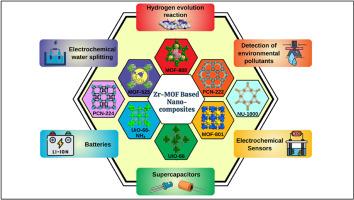锆基金属有机框架和纳米复合材料:电化学应用中的结构-功能相关性
IF 8.2
2区 材料科学
Q1 MATERIALS SCIENCE, MULTIDISCIPLINARY
引用次数: 0
摘要
锆基金属有机骨架(Zr-MOFs)由于其优异的化学稳定性、可调节的孔隙率和氧化还原活性,已成为电化学应用中适应性极强的材料。本研究详细分析了Zr-MOF的合成方法,包括溶剂热法、绿色合成法、机械化学方法和合成后改变,重点关注结构多样性和定制功能。深入研究了zr - mof的基本电化学特性,如电荷输运、离子扩散和电化学稳定性,以及通过与石墨烯和碳纳米管等导电材料制备纳米复合材料来提高性能的策略。zr - mof的多功能性通过其在环境电化学传感中的应用进一步探索,以检测有害污染物和能源相关技术,如超级电容器,电池和析氢反应(HER)。尽管它们有着巨大的前景,但诸如可扩展性、低固有电导率和长期运行稳定性等问题限制了它们的广泛应用。未来的发展方向包括导电zr - mof的发展,可持续的大规模生产,集成到下一代柔性电子产品中,以及电化学污染物降解。通过克服这些问题,zr - mof可以成为开发可持续能源存储和环境修复技术的一个改变游戏规则的平台。本文章由计算机程序翻译,如有差异,请以英文原文为准。

Zirconium-based metal-organic frameworks and nanocomposites: Structure-Function correlations in electrochemical applications
Zirconium-based metal-organic frameworks (Zr-MOFs) have emerged as extremely adaptable materials in electrochemical applications due to their outstanding chemical stability, adjustable porosity, and redox-active behavior. This study presents a detailed analysis of Zr-MOF synthesis methodologies, including solvothermal, green synthesis, mechanochemical approaches, and post-synthetic alterations, focusing on structural variety and tailored functionality. The fundamental electrochemical features of Zr-MOFs, such as charge transport, ion diffusion, and electrochemical stability, are thoroughly investigated, as well as strategies for improving performance through nanocomposite creation with conductive materials such as graphene and carbon nanotubes. Zr-MOFs' multifunctionality is further explored through their use in environmental electrochemical sensing to detect harmful contaminants and energy-related technologies such as supercapacitors, batteries, and the hydrogen evolution reaction (HER). Despite their enormous promise, issues such as scalability, low intrinsic conductivity, and long-term operating stability restrict their broad implementation. Future directions include the development of conductive Zr-MOFs, sustainable large-scale production, integration into next-generation flexible electronics, and electrochemical pollutant degradation. By overcoming these problems, Zr-MOFs could be a game-changing platform for developing sustainable energy storage and environmental remediation technologies.
求助全文
通过发布文献求助,成功后即可免费获取论文全文。
去求助
来源期刊

Materials Today Nano
Multiple-
CiteScore
11.30
自引率
3.90%
发文量
130
审稿时长
31 days
期刊介绍:
Materials Today Nano is a multidisciplinary journal dedicated to nanoscience and nanotechnology. The journal aims to showcase the latest advances in nanoscience and provide a platform for discussing new concepts and applications. With rigorous peer review, rapid decisions, and high visibility, Materials Today Nano offers authors the opportunity to publish comprehensive articles, short communications, and reviews on a wide range of topics in nanoscience. The editors welcome comprehensive articles, short communications and reviews on topics including but not limited to:
Nanoscale synthesis and assembly
Nanoscale characterization
Nanoscale fabrication
Nanoelectronics and molecular electronics
Nanomedicine
Nanomechanics
Nanosensors
Nanophotonics
Nanocomposites
 求助内容:
求助内容: 应助结果提醒方式:
应助结果提醒方式:


